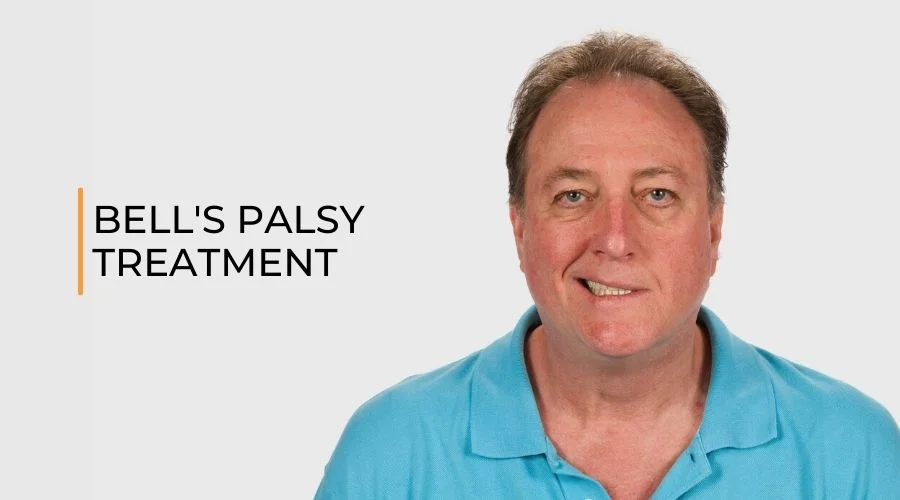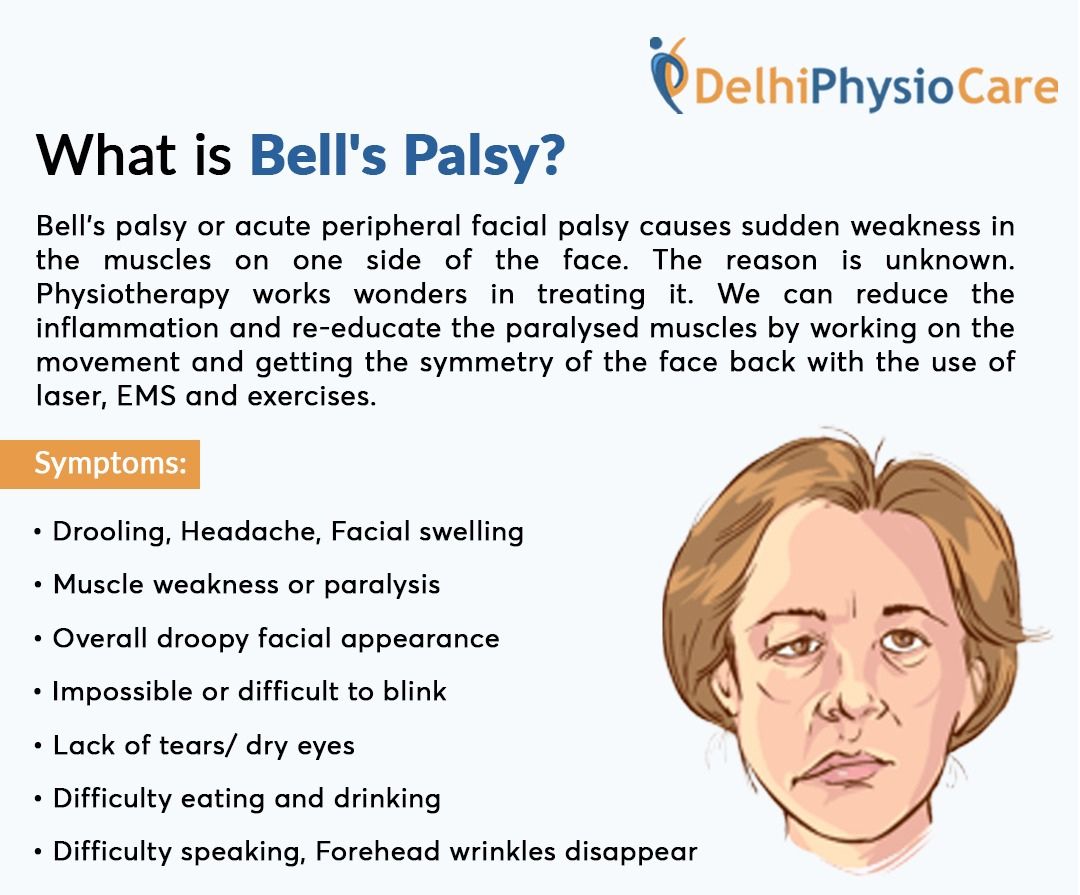Bell’s Palsy Treatment
Home / Bell’s Palsy TreatmentBell’s Palsy Treatment in Delhi

Bell’s palsy, also called idiopathic facial paralysis, is an inexplicable condition of facial muscle weakness or paralysis. In other words, Bell’s palsy is sudden muscle weakness in the middle of the face.
It starts suddenly and gets worse within 48 hours. This condition is caused by damage to the facial nerve (seventh cranial nerve). Pain and discomfort usually occur on one side. Bell’s palsy can affect people of any age.
Bell’s palsy may be a response to a viral infection and rarely occurs more than once. It is characterized by muscle weakness, leading to sagging half of the face.

Bell’ palsy isn’t caused by a stroke, however it will cause similar symptoms. Bell’ palsy sometimes resolves in time and causes no permanent complications. However, throughout the duration the person with Bell’ palsy is unable to shut their eye on the affected side of their face. It is, therefore, vital to guard the attention from drying in the night.
Signs & Symptoms
Bell’s palsy is characterized by muscle weakness, leading to sagging half of the face.
Early symptoms of Bell’s Palsy may include mild fever, pain behind the ears, neck stiffness, and weakness and/or stiffness on one side of the face. Symptoms may appear suddenly and progress rapidly within a few hours, sometimes after exposure to cold or air currents.
Some common symptoms of Bell’s palsy are –
- Rapid onset of weakness to total dysfunction on one side of the face.
- Facial droop and issue creating facial expressions, like closing your eye or smiling.
- Drooling.
- Pain around the jaw or in or behind your ear on the affected side.
- Exaggerated sensitivity to sound on the affected side.
- Headache.

Causes of Bell’s Palsy
Though the cause of Bell’s palsy is unknown, many medical researchers believe that it is most likely caused by a viral infection.
Viruses/bacteria associated with Bell’s Palsy are:
- Herpes simplex, which can cause herpes and genital herpes.
- HIV, which can damage the immune system.
- Sarcoidosis, which can cause organ inflammation.
- Herpes zoster virus, which causes chickenpox.
- Epstein-Barr virus, which causes mononucleosis.
- Lyme disease, a bacterial infection caused by an infected tick.
Physiotherapy Treatment for Bell’s Palsy
-Physiotherapy helps in preventing the facial muscles from permanently contracting and losing its tone. Physiotherapy helps to fasten the recovery. There are many treatments available that help in faster recovery without any residual paralysis.
1) MIME Therapy- It is neuromuscular retraining where along with the facial exercises that are taught by the therapist to the patient, emotional input is added to get better movement.
For eg. remembering a happy moment when smiling.
The main techniques used are:
– Relaxation exercise (holistic approach mainly focuses on breathing)
– Massage therapy
– Emotion expression exercises.
MIME therapy helps in reducing the severity of the paralysis by improving the symmetry on both sides of the face.
2) Proprioceptive Neuromuscular Facilitation (PNF) technique- It is a type of exercise program where the therapist resists the movement on the strong side (or the normal side) of the face, while simultaneously assisting in the movement of the affected (paralyzed) side.
It should be done in front of the mirror where both the therapist and patient can get visual feedback.
3) Electric Muscle Stimulation( EMS): Muscle stimulation is done by a pen electrode that is placed at the motor point of each muscle and contracts the muscle.
Due to the paralysis, the muscle gets innervated and tends to get flaccid.
EMS helps in maintaining the tone of the muscle.
4) MASSAGE- Massaging different areas of the face helps in strengthening and regaining the movements.
The Most commonly done areas are:
– Upper Facial Muscles- Massage the upper portion of the face. Start from the forehead in the upward direction and then maintaining the movement, get it towards the ear.
– Lower Facial Muscles- Massage the area on the affected side starting from the corner of the mouth like starting a smile. Take it towards the ear.
– Cheeks- Circular massage technique around the cheeks area.
Each area has to be done with the repetition every 3-4 hours.
5) EXERCISE– Though bell’s palsy is self-limiting, exercises for the facial muscles help in faster recovery, maintain the symmetry of the face, and reduces the problem in the patient’s facial functions.
– These exercises increase muscle strength and coordination
– The main purpose of doing these exercises number of times in a day is reeducating the muscles. When the nerve gets damaged and the brain doesn’t get the signal, it tends to forget the muscle action. When we keep exercising we keep re-educating the brain, hence creating.
The brain—to the nerve—to the muscles action
– These exercises should be done in front of the mirror to maintain symmetry. Use your fingertips in doing the muscle action in the right direction, while stimulating the muscle.
– The most commonly done exercises would be,
a) Raising the eyebrows, as in a surprise
b) Getting the eyebrows together, when you frown
c) Wringing the nose upwards
d) Filling air in the cheeks
e) Blowing air out
f) Closing the eye
g) Smiling
These are the general facial exercises for bell’s palsy, but each bell’s palsy can have some different presentations. So, the exercises need to be appropriately planned for each person.

At our clinic, the plans are tailor-made. Exercising the wrong muscle can do you more harm than good.
WE CAN PUT TOGETHER A TREATMENT FOR YOUR BELL’S PALSY
Follow your therapist. Do the correct exercises.
It is the only way to improve your facial muscle strength and coordination.
Quick Enquiry
Send us a message with your contact details and one of our staff will contact you right away.
TREATMENTS
BOOK AN APPOINTMENT
GENERAL ENQUIRIES
235, Avtar Enclave, Paschim Vihar, Delhi – 110063
Bell’s palsy Treatment FAQ’s
Seek immediate medical help if you experience any type of paralysis because you may be having a stroke. Bell’s palsy is not caused by a stroke.
With or without treatment, most individuals begin to get better within 2 weeks after the initial onset of symptoms and most recover completely, returning to normal function within 3 to 6 months.
Bell’s palsy occurs when the seventh cranial nerve becomes swollen or compressed, resulting in facial weakness or paralysis. The exact cause of this damage is unknown, but many medical researchers believe it’s most likely triggered by a viral infectionrn ACL experience swelling and pain in the knee. They face difficulty in walking as well.
Though there is no fixed method for healing Bell’s palsy quickly experts often suggest face massage helps a lot. A gentle massage of your face and neck for few minutes daily will improve your blood circulation resulting in nerve regeneration speeding.
Yes, it is not a permanent condition and one can recover fully in some time. But in rare cases, it doesn’t go away with time.
In most cases, Bell’s paralysis is temporary. After about two weeks, you may notice a gradual improvement. Most people fully recover their facial mobility and function within three months.
